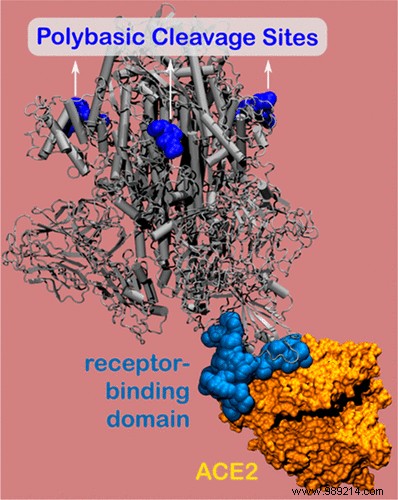Viral S-proteins interact with a cellular receptor to allow SARS-CoV-2 to enter our cells. However, US researchers have brought to light an area of this protein source of hope. By modifying it, it would be possible to reduce the intensity of the interactions.
Since the appearance of the coronavirus SARS-CoV-2, the S (surface) protein is certainly the most studied element of its structure. This protein binds to angiotensin-converting enzyme 2 (ACE2), a receptor allowing the coronavirus to enter a host cell. However, the S protein has a particular area, the Receptor binding site (RBD). This corresponds to the end of the protein directly in contact with the ACE2 receiver.
In a study published in the journal ACS Nano on August 2, 2020, researchers from Northwestern University (USA) say they have identified another interesting area of protein S. This is very close to the RBD zone (10 nanometers). According to the study leaders, if this new area is modified, the RBD-ACE2 binding could be weakened.

Researchers suggest a polybasic cleavage site , composed of three arginines and one alanine giving it an overall positive charge for an enzyme called "furin". However, this cut is necessary to activate the fusion of the viral envelope with the membrane of the host cell. Thus, the scientists made a comparison between the RBD-ACE2 link regarding the basic S protein with two mutants whose polybasic cut has been modified. In the case of the first mutant, the scientists removed the amino acids from the polybasic site. For the second, it is a question of replacing two of these amino acids.
Results show a reduction in RBD-ACE2 interactions of 36% for the first mutant and 20% at the second level. This made it possible to understand that modifying part of the S protein outside the RBD also makes it possible to influence the ability of the protein to infect our cells! Given the quality of the results obtained by the researchers, they believe that it is necessary to target this polybasic site in a therapeutic way. Scientists have also synthesized a small peptide composed of four negatively charged amino acids. The results are promising since it is a question of a 41% reduction in hydrogen bonds . Thus, this lays the foundation for a treatment that weakens the RBD-ACE2 link.
On the other hand, you should know that for the moment, this research remains theoretical . Indeed, no test has been performed in vitro. The researchers are only at the stage of assuming that the weakening of the interactions between the RBD and ACE2 can reduce the infectivity of the coronavirus.